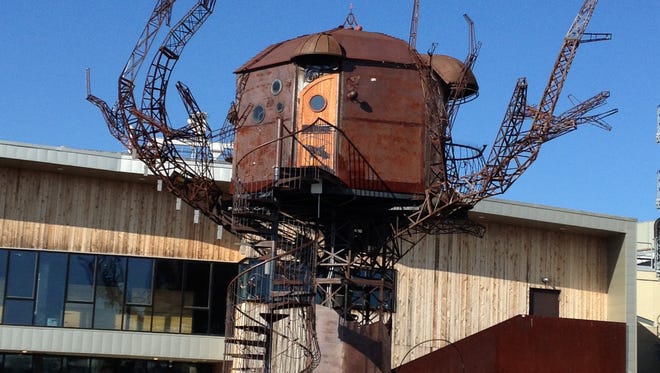Public art blossoms: Whirligigs, tree houses and statues
Coastal Delaware has a long tradition of creating and supporting the arts. The Rehoboth Art League, the Dewey Artist Collaboration and the Lewes Artists Studio Tour are a few examples of our vibrant art scene.

In addition, hardly a month goes by without some local arts and crafts show, where one can find everything but the kitchen sink, and sometimes that’s there masquerading as a planter.
Recently, we have witnessed renewed interest in public art, the outdoor display of works for people to view and consider. In mid-September, the Lewes City Council approved the installation of three so-called “whirligig” sculptures to be installed at the new trailhead along Freeman Highway.
The relationship between these abstract windspinners, handmade of marine-grade copper and stainless steel, and the woodland trails that they will abut, is not exactly clear to this columnist, unless the intent was to banish these sculptures to the hinterlands.
Predating this “whirligigery” was the installation of the Steampunk Tree House at the Dogfish Head brewery in Milton. Dedicated to bringing off-centered beer goodness to off-centered people, it was not surprising that the folks at Dogfish Head wanted to possess the Tree House when this piece of off-centered art became available.
Forty feet tall, with branches that extend out an additional 40 feet, and topped by a 15-by-12 foot hexagonal room, the Steampunk Tree House is something to behold. It’s also something that’s not likely to be moved again soon, given that it weighs eight tons.

Incidentally, according to Wikipedia, “Steampunk” is a type of science fantasy “that incorporates technology and aesthetic designs inspired by 19th century industrial steam-powered machinery.” Steampunk, therefore, is not a variant of punk rock in which the musicians play hot air, rather than electric, guitars.
A more down-to-earth example of public art, both in terms of size and relevancy, is “Fearless Girl,” a bronze statue created last spring by Lewes-based sculptor Kristen Visbal for International Women’s Day.
READ MORE: These homes are a window into post-World War II history
At a little over 4 feet tall, Fearless Girl would seemingly be no match for the public art behemoths previously described, or for the 11-foot tall “Charging Bull” statue that she's placed across from and faces in New York City’s Financial District.
Nonetheless, once installed, Fearless Girl became an international sensation. With her clenched fists on hips pose, defiant facial expression, and hightop sneakers or shoes, she appears to be more than able to stop the bull should it actually decide to charge.
Originally designed to be on exhibit for just one week, Fearless Girl’s popularity and symbolism have resulted in a stay that will last through February 2018 at least. Bad news for the bull of Wall Street.

But the granddaddies of public art in this region are probably the statues of Nanticoke Indian Chief Little Owl, a version of which has greeted visitors to downtown Bethany Beach for 40 years. Intended to be a tribute to the Nanticoke Nation, the statues unfortunately have shown the fragility of outdoor art, especially when made of wood.
The first version, carved from a poplar log, lasted only 16 years. It was weakened by termites and eventually destroyed by high winds. Its successor fell victim to wood rot, and the town was forced to remove it after a mere 8 years.
The newest version, dedicated in 2002, is made from red cedar and is predicted to last 50-150 years. Personally, I’d be pleased if it were still standing in 2026, when Bethany Beach will celebrate the 125th anniversary of its founding.
READ MORE: Ministry of Caring, Sunday Breakfast Mission launch holiday drives
There can be little doubt that the pieces of public art described above are significant. But, perhaps, our thinking has not been as expansive as it should be.
Back in 280 BC, a year which most of us have only dim memories of, the Greeks erected the Colossus of Rhodes, overlooking the entrance to that island's harbor. Considered one of the Seven Wonders of the Ancient World, it stood some 108 feet high.
Maybe we should consider erecting a similar statue near the mouth of Rehoboth Bay, and call it the Colossus of Rehoboth. After all, it couldn’t cost much more than the new City Hall.
Mike Berger is a freelance writer and retired university administrator with a home in Lewes. Contact him at edadvice@comcast.net.